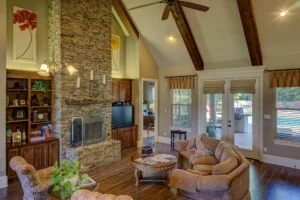You dig how real wood floors look, cozy, full of life, like they turn any space into something unique. Yet you’ve probably heard the downsides. It might bend, split, or gap when the air gets damp or dry. Perhaps your house sits on a concrete base, and someone said nailing down solid planks there is a no go.
This is where engineered hardwood steps in, offering a fresh take on classic looks without the hassle. Instead of solid wood, it brings together layers that handle changes better.
Why Was Engineered Wood Even Invented?
To get how engineered hardwood works, think about the issue it fixes. Years ago, people could pick just one option, solid wood.
The Problem with Traditional Solid Wood
Real hardwood works well, yet it’s just one dense chunk of timber. Trees make wood, so it acts alive. Humidity changes mess with it. Too much dampness? It puffs up. When the air gets dry? It pulls back.
This shifting might lead to issues. Sometimes it’s unpredictable, yet often noticeable.
- Gapping: When winter’s dry air hits, planks might separate slightly and tiny spaces appear here or there.
- Cupping: One side of a board might lift above the middle.
- Curving: A whole board might bow or turn after a while.
These problems get worse where temps change a lot, like basements, or above concrete floors that trap dampness.

The Engineered Solution
Engineered hardwood came about because people needed a better solution. This smart design brings the look of real wood while using newer methods for toughness and balance.
A Look Inside: The Layers of Engineered Hardwood
Picture engineered wood as a clever stack, kinda like lunch food, but smarter. Each board is built from several sheets piled up just right. One layer sits on top of another, held tight in a certain order.
The Wear Layer (Your Floor’s Armor)
This one is what you actually step on every day. Made from genuine pieces of tough hardwood like oak, maple, or even hickory. Since it is not fake, the look and touch feel just like full solid wood underfoot. How thick that surface part is goes by the name “wear layer.”
The Core (The Stable Heart)
Beneath the surface sits the core, the key to balance. Made of several sheets of plywood or dense fiberboard, each layered against the next. The crossing pattern gives strength. That setup holds planks steady and stops them swelling, warping, or bending.
The Backing (The Solid Base)
The lower part is just a slim wooden slab. This one gives a smooth, steady platform when putting it together.

Engineered vs. Solid Hardwood: The Honest Comparison
One is a solid pick, yet the other fits better depending on what you’re doing.
Key Advantages of Engineered Wood
Steady performance stands out most. Because it won’t shift when dampness or heat changes, it works well below ground level. That means good results in cooking areas too. People in places with extreme wetness or dry air also find it reliable.
Easy setup at home: Lots of options snap together or stick right onto concrete with adhesive. That’s easier compared to hammering planks into plywood, since real wood needs a base made of timber underneath.
Thanks to its stability, engineered planks usually come in bigger sizes, wider and longer than solid wood options, which means a richer appearance with less visible joints.
Key Advantages of Solid Wood
A solid wood floor lasts up to 100 years. Since it’s made from dense timber, you can sand and renew it repeatedly through time.
Pumps up worth: Dense wood usually feels like a step-up option, so it could boost your house price.
Heavier wear layer means the whole board is made of real timber, so you can refinish it again and again with no risk of hitting a base layer underneath.
Is Engineered Hardwood Right for YOU?
Let’s pick a floor that fits how you live.
Perfect for Busy Families and Pets
If you’ve got children, pets, or constant movement through rooms, go for engineered hardwood. It holds up well. Since it’s built to stay steady, bumps and scrapes don’t show as fast compared to more delicate solid types. A number of versions include a rugged coating added during manufacturing, ideal for hectic days.
The Ideal Choice for Concrete Slabs
If your house sits on a concrete base, engineered hardwood might be the top choice, or really the only one. Since it sticks right onto the slab, you get a tough, good-looking floor in spots real wood won’t work.
Frequently Asked Questions (FAQs)
Q1: Can you refinish engineered hardwood floors?
Yep, it’s possible, though how often depends on the top layer’s thickness. If you’ve got a solid engineered floor with at least 3 mm of wear surface, sanding it 2 or 3 times should work fine. Still, go by what the maker says in their guidelines.
Q2: Is engineered hardwood real wood?
Yep, for sure. Up top, it’s solid hardwood, no fake stuff. What you see underfoot is the real deal, nothing less.
Q3: What’s the difference between engineered wood and laminate?
This question pops up a lot. Instead of actual wood, laminate uses a sharp image of wood stuck on top of processed fiberboard. It doesn’t have any natural timber in it. On the flip side, engineered hardwood carries a genuine piece of real wood laid across its surface.
Q4: Can engineered hardwood be used in a kitchen?
Yep, works well in kitchens. Since it’s stable, it can deal with steam and moisture from cooking. Still, wipe up splashes fast, same as you would with any wooden flooring.
Your Smart, Beautiful Floor
What’s engineered hardwood flooring? This clever option mixes natural wood charm with solid durability thanks to its layered build. You get looks that impress plus resilience that lasts through daily wear.
It’s ideal for folks at home chasing that wood appearance minus the usual headaches. This flooring handles everyday messes like a champ.
